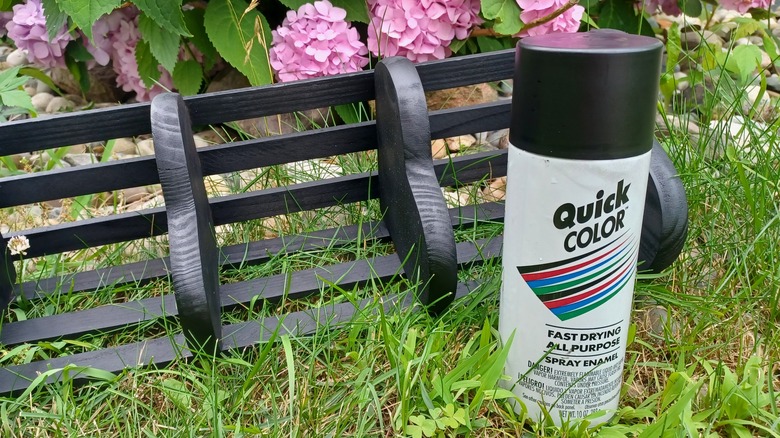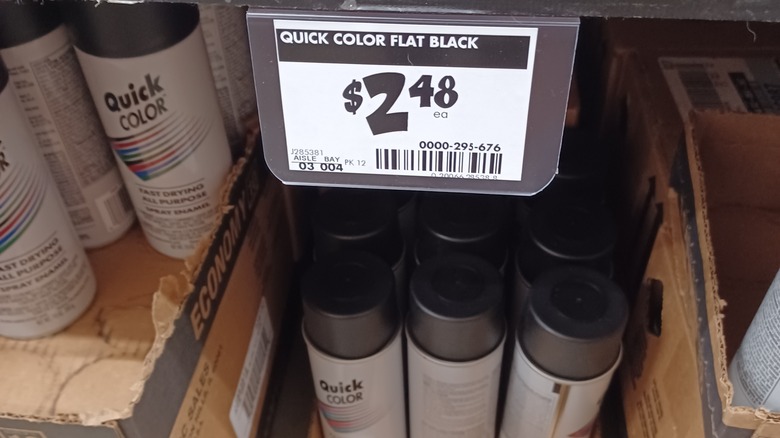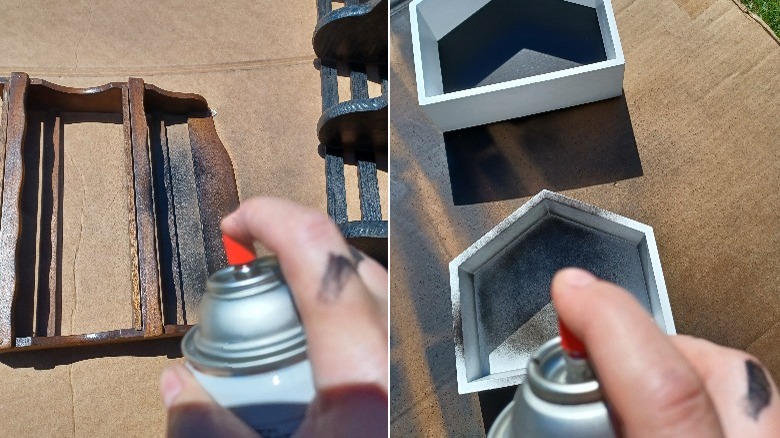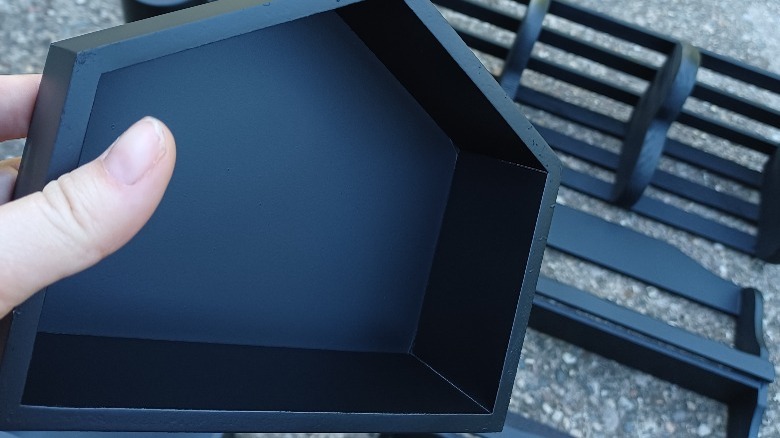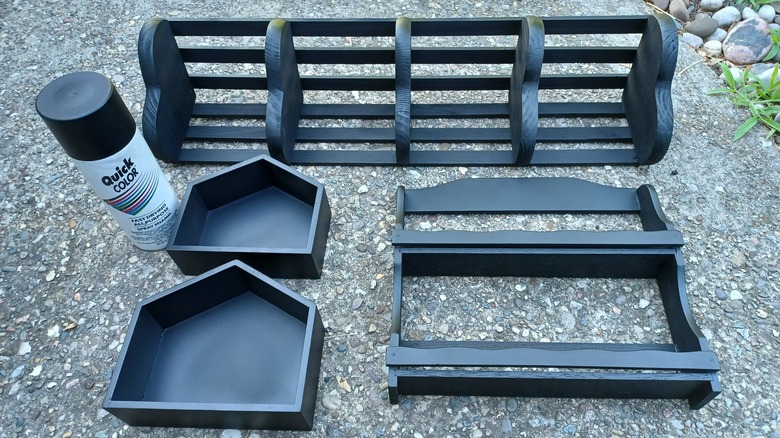We Tried The Cheapest Spray Paint At Home Depot. Here's How It Went
We may receive a commission on purchases made from links.
When it comes to purchasing spray paint, there are many factors that determine which one of those cans you want to buy. Not all brands or types are created equally; some only work well with porous materials, like uncoated wood, while others will adhere to plastic like a charm.
Picking the brand of spray paint you need for a project isn't as important as choosing the right type you'll need in many cases. MasterClass breaks down 10 different kinds, which includes the general purpose option that works on an array of bases, including wood.
To test out whether or not a lower-priced option is worth the smaller dent in our wallets, we went to our local Home Depot and perused the selection to find the one with the absolute lowest price tag. We came home with Quick Color spray paint. We wanted to determine if you get what you pay for or if this cheap can of paint would actually get the job done.
Quick Color cost and details
We decided to go with basic black when picking out a hue from the Quick Color brand at The Home Depot. You can get black or white in flat, or black, white, red, or green in glossy. We went with flat because it will go well with the walls the finished items will someday hang on.
This 10-ounce can of spray enamel has a low, low price of $2.48. That's a drastic difference from many of the other spray paints The Home Depot sells, which run anywhere from $5.98 to $10.25 a can. It's advertised as a paint that will dry fast and can be used for multiple purposes. Since we were using various types of wood for this experiment, that's what we went for. Fast-drying and multi-purpose are both ideal keywords when you're using spray paint for a craft project, after all.
The real question is: Does it really do what it says? The reviews on The Home Depot website are all over the place. One five-star reviewer noted, "Everything worked out great. The paint is awesome," while a less happy customer wrote, "Very little pigment on the color," after having to put on several coats of the paint.
Testing out Quick Color on wood
Without much confidence in using a cheaply-priced spray paint on plastics after having bad experiences in the past (plastic dinosaurs that remained forever sticky being just one of those), we opted to work with wood items, though we went with some different starting colors and wood types. FYI, The DIY Plan offers up some tips for dealing with sticky paint, though not all tricks work in different cases.
Each item we spray painted needed a little something different, aside from being painted black. The already-painted black shelves needed a touch-up because its color was faded. It also had a couple of splotches of white paint that had to be covered. The brown wood spice rack simply needed to become a black wood spice rack. Plus, we had a set of white shadow boxes made of wood that was already solidly coated (not sure with what, but it wasn't porous). Aside from starting with clean slates (washed of any dust and then dried), we didn't do any prep work like sanding. We experienced different results with each item.
How Quick Color exceeded our expectations
We dove right into painting and found that the can of Quick Color was easy to spray. As avid crafters, we know how painful some spray paint cans are to use. The stream wasn't drippy like some spray paints are — in fact, it never dripped. Even at the end of the canister, the spray went on as smooth as it did in the beginning. We also didn't notice any issues with the stream going too wide or even getting too concentrated — it was just right for our needs.
The Quick Color spray paint did a decent job covering a white piece of wood that already had a bit of a glossy finish, though it only needed a couple of coats — we'd say that's some proper pigmentation, especially for the price. The black shelf only needed one coat, with an extra spray here and there on those white paint splotches. The brown spice rack got two coats and might have done even better with a third (which wasn't noticed until after the can of paint was empty), but it still looked good.
One other benefit this paint has is that we were able to spray paint all four items with one can of paint! Once the objects were fully dry, the matte tone really showed on each piece, helping hide any imperfections in these old shelves — which is a good reason to opt for matte.
How Quick Color could be improved
There were some edges and crevasses in the white shadow boxes that stayed white, even after two coats of Quick Color. We were actually a little surprised by this because this spray paint goes on extra wet (so much so that you need to be careful not to end up with a bunch of drips all over the place). Of the two negatives that we had with our experience with Quick Color, that had to be the worst.
The only other issue was that the dry time on those white shadow boxes was over an hour. The more porous wood shelves did dry quickly, as the spray can advertises, but the less porous shadow boxes took longer and remained tacky after 60 minutes. By giving items a couple of hours of dry time between coats you may not have any issues. Perhaps sanding the original coating off these boxes would have helped as well. Rain on a Tin Roof explains why sanding can sometimes be necessary before a fresh paint job.
As spray paints often have, there was a strong odor, and we were happy we decided to complete this project outside. You definitely want to use this (and any spray paints, for that matter) in a well-ventilated space. We'd also recommend wearing gloves — while the can wasn't drippy, we did still manage to get our hands covered in spray paint, and it took days to wash all that black off.
Our final verdict
Would we buy this item again? Honestly, we were pretty impressed with the Quick Color spray paint from The Home Depot. It gave us just what we needed: a bunch of cute black shelves. Previous projects with Krylon spray paint required two coats of paint in some cases as well, and that brand costs two to three times the amount of this cheaper option, so the Quick Color paint really did stand up for itself. We don't know that we'd trust it on plastic, but for spray painting wood it does a great job.
While you may not want to buy this if you're working on a professional job, Quick Color spray paint makes an excellent affordable option for extra coverage jobs, dealing with fading, and covering uncoated wood products. It's an excellent option for crafters and artists who use a lot of spray paint and want to save some money. If you're painting something a much darker shade than its original, you may want to go with a pricier paint that offers fuller coverage, however.
